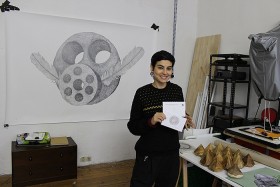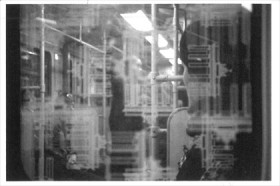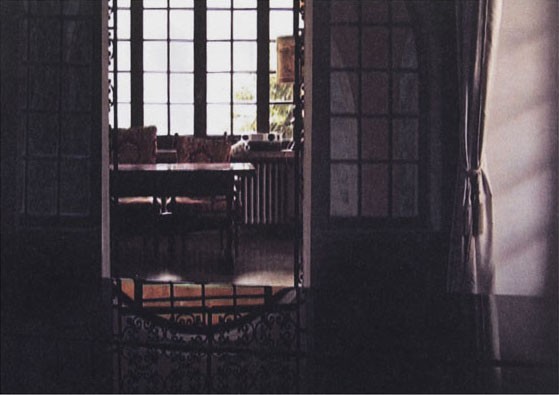With Her Art Shira Wachsmann Addresses the Nearly Forgotten Genocide of the Herero and Nama Peoples in Present-Day Namibia

The artist Shira Wachsmann in her workshop
CC-BY Saro Gorgis
The streets of Kreuzberg are soaked through with rain on this grey February day. Shira Wachsmann, a graceful young woman with short black hair, leads me into her atelier in a pre-war apartment. She doesn’t have much time. Her solo exhibition “Tribe Fire” is scheduled to open on 13 March 2016 in the gallery cubus-m in Berlin’s Schöneberg neighborhood (further information on the gallery’s website). It will remain there until 23 April. Large drawings, soon to become part of the Tribe Fire installation, hang in the atelier. “There’s still a lot to do,” the Israeli native explains.
Her most recent art project is spread across her desk: two postcards that Wachsmann designed for the Jewish Museum Berlin. She produced editions of 400 of each piece, which have been available for individual purchase since 1 April 2016 in the art vending machine of the museum’s permanent exhibition (more information on the art vending machine on our website). Wachsmann takes a seat in a green armchair and ponders the cards. They show two circular motifs, a form that appears throughout the artist’s work like a guiding principle. Here they depict an abstract diamond and a black sun. → continue reading
Daphna Westerman’s Postcards in Motion

One of Daphna Westerman’s postcards, front view. © Jewish Museum Berlin, Photo: Lisa Albrecht
Did you find a postcard like this one in your mail box as well? Or have you even pulled the entire road movie by Daphna Westerman out of our Art Vending Machine? By now the Machine is sold out completely. But no need to stop the movie! Let’s just rewind a little…
Before the work of the Israeli artist ended up in the museum’s Art Vending Machine, I received a postcard with a black and white photograph. Except for my address and the title, “U-Bahn Berlin. From In and between the cities, 2011. A film by Daphna Westerman,” there was nothing more to it. A few days later more cards were in the mail. Time to phone Daphna. → continue reading
An Interview with Daniel Laufer
You can buy a wide variety of works of art from our art vending machine. One such piece is a postcard by Daniel Laufer (*1975, Hanover).
The card shows a film still from the video, “The Fourth Wall” (at 08:13 min). The story is based on an Hasidic parable about two men who are supposed to design one half of a house. While the first man does his work with zeal, the second delays, uninspired. The second man, who is certain that he won’t come up with a better idea than his rival, decides to coat his work with black bitumen. The material will reflect the other half of the house like a mirror. Thus he discovers a good solution to avoid defeat.

Postcard with still shot from the film “The Fourth Wall” by Daniel Laufer
© Jewish Museum Berlin, photo: Jens Ziehe
The film was shown this year at the 14th Videonale at the Bonn Art Museum.
In the following interview, Daniel Laufer talks about the genesis and message of his postcard.
Christiane Bauer: Daniel, you work mostly in video form. Yet you produced a postcard for the art vending machine. Why did you choose this format?
Daniel Laufer: A postcard is something mobile that you can take with you. It connects you to something: it provides information and contains a message. It can be a souvenir – but with a statement. And I also like the fact that you can hang it on the wall.
The original work of art is an entire film. Why did you choose this particular shot as a motif for the postcard? → continue reading


